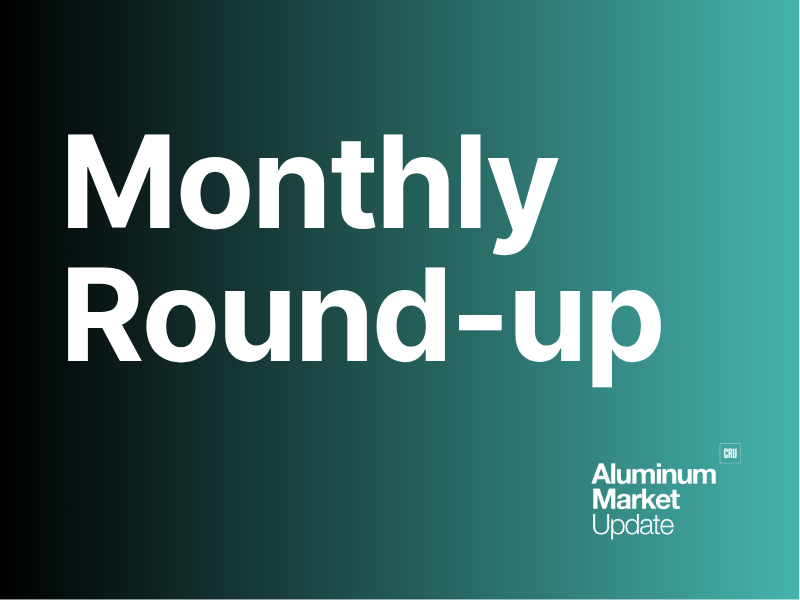Monthly Round-up

October 2, 2025
Monthly Round-Up: Survey results, company expansions, and electricity needs
Written by Stephanie Ritenbaugh
There’s a lot of news to keep track of, so we’re lending a hand with highlights from the past month and what they mean for you.
Aluminum Market Update’s August survey showed respondents pointing to a market defined by diverging lead times across product groups. The share of respondents citing “extending lead times” rose to 26% in August from 17% in July, while those who answered “shrinking” fell to 9% in the most recent month. We dug into the data and and what survey respondents are saying.
Facilities
As EGA/Spectro Alloys prepares to open its first metal casting at its Rosemount, Minn., secondary billet casthouse. We take a look at the status of other secondary projects announced over the years. Several have been put on hold: MX/Century Aluminum’s secondary billet plant in Leetonia, Ohio; Adaptiq’s secondary billet plant in Cincinnati; and Metal-X’s project in Defiance, Ohio. But the outlook for value-added products and scrap could be improving.
A non-profit organization, Health Over Wealth, is challenging the approval by city officials in Benson, Ariz., of Aluminum Dynamics Inc.’s scrap recycling and casting facility in the state. The activist group argues the project was approved improperly and poses risks to residents and the environment.
A Novelis plant in Oswego, N.Y., remains offline following a fire that broke out on Sept. 16. The facility is the largest producer of automotive alloys in North America and a key supplier for automakers. AMU’s Nicholas Bell breaks down how a prolonged shutdown of Oswego could impact the aluminum market.
Ball Corporation, Red Bull, and Rauch Fruchtsäfte have broken ground on a 2.3-million-square-foot production, manufacturing, and distribution facility in Concord, N.C. The plant is slated to begin operations in 2028, with capacity expected to reach up to three billion cans annually by 2031.
Arconic has completed a $57.5-million expansion at its Davenport Works in Iowa, effectively doubling US production capacity of high-purity aluminum.
Waste Management (WM) has opened two recycling plants, one each in Pennsylvania and in Oregon. It’s part of the company’s plan to invest more than $1.4 billion in building or upgrading 39 recycling facilities across North America through 2026. As of Q2’25, WM has completed 29 recycling automation and growth market projects out of the 39 planned. The company’s goal is to increase the amount of material recovered annually from 16 million tons in 2024 to 25 million tons by 2030.
Trade
LME contango or backwardation. These are the so-called “spreads” that prevail between the LME cash price and the LME 3-month price. People engaged in selling downstream, physical aluminum are tempted to ask, “Why do I really care about these spreads?” Many downstream sectors don’t react to these spreads on a daily or weekly basis. But the downstream market is still affected.
It has been a difficult year for Canadian producers. They have gone from enjoying complete exemption from Section 232 tariffs to paying 50%. However, shifting Midwest and European premiums could favor Canada.
The United States Trade Representative (USTR) port fees will take effect on Oct. 14. These fees are much like the tariffs – a yet-to-be-realized punch to the US economy. While Chinese carriers are clearly going to take a major financial hit, eventually the market is going to have to price Chinese capacity back into the US. Why? There simply is not enough non-Chinese capacity to fulfill demand.
The Canadian government has rolled out a sweeping set of measures to shield industries most exposed to US tariffs. Aluminum has been singled out as critical to the country’s economic future. The initiative comes after months of tit-for-tat trade spats between Canada and the US.
Public comments are open on the USMCA to offer feedback on how the agreement is functioning. USMCA is the trade deal between the U.S., Mexico, and Canada that was struck during President Trump’s first term to replace NAFTA. You still have time to submit your thoughts.
International Monetary Fund (IMF) and the Organization for Economic Cooperation and Development (OECD) released their reports on the global economy. Broadly speaking, the OECD is more positive on growth than you’d think.
Scrap
Aluminum demand in the US and Canada slipped fell 4.4% during the first half of the year, according to preliminary estimates from the Aluminum Association. The year-over-year decline was partly due to a significant drop in exports. That said, demand also fell in all market segments – except for foil.
A European aluminum association is urging the European Commission to impose export fees on scrap to keep more of the recycled metal at home for the industry’s use. Scrap exports reached a record high of 1.2 million tonnes in 2024, according to the Belgium-based European Aluminum. The group added that ~40% of the EU’s aluminum consumption comes from recycling. But ~15% of Europe’s recycling furnace capacity is idled due to a lack of scrap availability.
Automakers on both sides of the Atlantic are moving to address how aluminum and other materials are handled at the end of a vehicle’s life. In the last year, company-wide strategies that target the dismantling of end-of-life (EOL) vehicles, the recovery of scrap alloys, and the reuse of those materials has taken center stage. Across Europe, Audi, Stellantis, Toyota, and others are expanding closed-loop systems focused on the dismantling infrastructure of EOL vehicles. Honda’s pilot plant in Ohio shows the beginnings of a similar shift in North America.
Energy
Electricity is a critical component to running smelters. Two projects big smelting projects have been announced: Century’s 400,000-500,000t/yr greenfield smelter and Emirates Global Aluminium’s planned 600,000t/yr greenfield smelter in Oklahoma. So what’s the electricity landscape look like in the U.S.? Here are a few takeaways: Energy demand is rising. So are wholesale prices.
We’re going to need more power. There are concerns we are not building enough generation and transmission capacity to meet electricity growth over the next five years. How do we break the logjam on the interconnection queue?
The solar panel market has been a major driver of growth in aluminum extrusions, particularly in China, where massive deployment of photovoltaic energy has taken place. In recent years, Chinese solar panel demand has topped 2 million tons per year. How does the market look going forward? There are a lot of factors at play, including tariffs, and disappearing incentives.
Around the market
Prices are poised to increase in 2026. AMU’s Greg Wittbecker does the numbers.
Commercial vehicle indicators for August showed persistent demand softness across truck, trailer, and recreational vehicle markets. One culprit: rising structural costs from newly imposed tariffs. While some seasonal ordering trends surfaced, underlying freight weakness and policy headwinds continued to dampen order activity and constrain production planning across the sector.
A group representing industries that use the rail system is warning a federal agency that Union Pacific Corp.’s proposed acquisition of Norfolk Southern Corp. could harm competition in the freight rail network – driving up costs and exacerbating service failures.
Union Pacific announced its intention to buy Norfolk Southern on July 29 for an enterprise value of $85 billion. If approved, the deal would connect over 50,000 route miles across 43 states from the East Coast to the West Coast. It would also link ~100 ports. The deal is currently under federal review. The Surface Transportation Board expects to receive a merger application by Jan. 29, 2026.




